Vol 2 No. 43 TROPIC LIGHTNING NEWS October 30, 1967
Index
ADC Chopper Turns ‘Dust Off’
“It was the finest piece of flying I’ve ever seen,” says BG William T. Gleason,
assistant 25th Div commander, describing how the pilot of his command helicopter
dropped into a postage stamp-sized hole in Viet Cong infested jungle to evacuate
three seriously wounded infantrymen.
With the rotors clipping tree branches, CWO Jimmy Bright from Bessemar, Ala.,
hovered over jagged tree stumps that could have torn open the belly of the
aircraft, while Gleason and his aide, LT James Murphy of Philadelphia, jumped
out to be replaced by the three wounded men.
The landing zone was carved out of the heavy jungle just north of the
Michelin Plantation, 72kms north of Saigon. The wounded were from the 3d Bn,
22nd Inf who had, an hour before, come under heavy automatic weapons and small
arms fire from an unknown-size enemy force.
Bright had intercepted a radio call for aid after an OH-23 helicopter with
skid-mounted litters had crashed while taking off from the landing zone with two
of the wounded.
“Mr. Bright requested permission to fly over to see if he could help,”
explained Gleason. After viewing the area, Bright picked a clearing 30 meters
from the downed OH-23. While orbiting, he instructed ground troops to cut down
certain trees to give himself enough room to set down.
Murphy felt that the area had at one time been hit by an air strike because
the clearing was covered with splintered stumps and fallen trees. “Bright
dropped the chopper straight down,” says Murphy, “and there wasn’t an inch to
spare, the rotors were hitting the branches.”
As they hovered, Gleason and Murphy jumped off and took cover with the
Infantrymen while the wounded were loaded on and flown to the nearest hospital
at Dau Tieng.
A few more trees were cut down enabling another helicopter to land and
extract three more wounded and the bodies of two men who had been killed.
“We were prepared to stay out there all night,” Gleason explained, “but CWO
Bright flew back for us 30 minutes later.”
Feeling very positive about Bright’s ability, Gleason says, “Mr. Bright was
in complete command of the aircraft. I had complete confidence in his ability
and judgment ... it was the finest piece of flying I’ve ever seen.”
2-34 Joins 25th ‘Utah’ To Tay Ninh
DAU TIENG - The firepower of one of the two armor units in Vietnam has been
added to the arsenal of the 25th Inf Div recently.
The 2d Bn, 34th Armor with some 60 medium tanks has moved to Tay Ninh where
it is under the operational control of the Tropic Lightning’s 3d Bde.
The heritage of the “Dreadnaught” battalion has been one of continuous
achievement. Created on August 28, 1941 the unit landed at “Utah” beach on July
27, 1944. At this time they became a part of Patton’s famous 3d Armor.
In the following months the 34th was given the opportunity to put into
practice a new concept of armored warfare. MG Lunsford E. Oliver, Commander of
the 5th Armored Div, was convinced that closer cooperation between the infantry
and Armor would result in less casualties and more effective fire
concentration. It was the effective utilization of this concept that enabled
the battalion to make history throughout World War II.
Breaking out of the Normandy Beachhead, the 34th formed a part of the armored
spearhead that closed the Ralaise trap, crushing the last German resistance
before Paris. Its superb performance helped make Patton’s historic lunge into
the heartland of Europe possible.
Proudly the records reflect that a dismounted patrol from the 34th was the
first allied unit to enter German soil September 11, 1944. On the 23d of April
1945, the war ended and the “Dreadnaught’s” mighty guns fell silent for
twenty-one years.
The beaches of Vung Tau and the jungles of South Vietnam are many years and
half a world away from “Utah” beach and the wheat fields of France. But when
the 34th Armor, then a part of the Fourth Inf Div. landed at Vung Tau on August
23, 1966 the unit still retained all the old “esprit” and fighting efficiency of
the old battalion.
Living up to its traditions of gallantry, the 34th has participated in
Operations “Attleboro, Sioux City, Lancaster, Cedar Falls,” and “Junction
City.” In these operations it proved, through results, that Armor did have a
place in counter-insurgency warfare.
During this period the battalion saw action as savage as any in the annals of
armed conflict. The “Fighting Aces” of Charlie Co, 2d Bn, 34th Armor on
February 20, 1967 destroyed over 400 of the enemy, as the VC launched a human
wave attack in a desperate effort to overrun the perimeter.
The battalion demonstrated its ability to move and fight in the jungle on
March 21, 1967. On this date landing zone Gold carne under siege by the 272nd
VC Regiment. Just as the embattled infantry and artillerymen were about to
exhaust their supply of ammunition, the 34th attached to the 2d Bn, (Mech) 22d
Inf, its tanks and APC’s on line and pouring fire, roared to the rescue.
In any capacity, whether it may be convoy escort, road clearance, search and
destroy operations, or fire-support missions the tanks and men of “Dreadnaught”
are ready to serve.
Pardner – That Was A Defensive Move
DAU TIENG - A number of Texans are known for their ability to rope, ride and
wrestle cattle but as far as 1LT Stanley Tidwell of Wichita Falls, Tex., is
concerned, this does not pertain to him.
Tidwell had his first bulldogging experience on a recent airmobile search and
cordon mission southeast of the 3d Bde. 25th Inf Div’s base camp. He was
returning to the 2d Bn, 12th Inf Command Post when a water buffalo, who seemed
to be upset because of the gunfire in the area, decided to charge the tall
Texan.
Tidwell decided to try to outrun the buffalo but seeing that he was losing
ground fast took refuge behind a large tree. The buffalo chased him around and
around the tree but Lieutenant Tidwell slipped and the buffalo ran over him and
continued on in a straight line, seeming satisfied that he was the winner.
Tidwell was uninjured except for the loss of a little of his Texas pride.
| STOP AND WATCH – Several tanks of the 2d Bn, 34th Armor, stop on a road clearing operation after receiving sniper fire. (Photo by SP4 James Huffstadt) |
 |
Immediate Delivery
DAU TIENG - An alert platoon leader from the 3d Bde, 25th Div accounted for
one Viet Cong killed in hasty ambush set up during Operation “Diamondhead”
northeast of Dau Tieng.
As the reconnaissance platoon of the 3d Bn, 22d Inf moved into an ambush
position for the night, Sterling W. Dodson of Lompoc, Calif., and Sgt William A.
Jadron of Joliet, Illinois made a preliminary survey of the jungle to the front
of the ambush.
“As we were checking the area out, two VC - one dressed in a khaki uniform
started down the trail toward us,” said the young platoon leader. “Jadron and I
opened up on them with our M-16’s and one dropped. The other ran off into the
jungle.”
One AK-47 assault rifle was captured from the dead enemy soldier and a blood
trail leading into the jungle where the second VC fled was also discovered.
SSG Tries Tarzan
Rides Inside Now
After a wild-swinging ride four hundred feet in the air, SSG Jacob Ortiz is
mighty glad UH-1D helicopters have landing skids.
Ortiz, a native of Denver, was on a combat sweep 48 kms northwest of Saigon
with Bravo Co, 2d Bn, 27th Inf “Wolfhounds”. The sweep had produced nothing but
a few bunkers.
The company regrouped in an open field for pickup and as the helicopters
approached the men, Viet Cong automatic weapons and small arms fire erupted from
the edges of the field.
Ortiz ran for the helicopter he was supposed to be on but it was already
full. Then he ran to a second helicopter but it took off before he could reach
it.
Nearly exhausted, he charged back to the first ship which was by then lifting
away.
He lunged for a skid, caught it and hung on.
The door gunner and several men in the ship grabbed him by the collar and
back of the shirt as the ship swept over hedgerows and began climbing.
They were nearly four hundred feet in the air before they managed to pull him
into the helicopter.
“I wasn’t too scared until I thought about it,” Ortiz said later, “Then I had
to sit down for a while.”
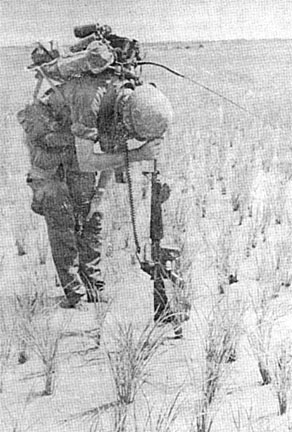 |
NO PLACE TO REST - A radio operator from the 2d Bn, 27th Inf, finds the only position to relax while standing in the middle of a flooded rice paddy. (Photo by SP4 Joe Carey) |
Page 2 TROPIC LIGHTNING NEWS October 30, 1967
Decorated
I believe that if we think clearly enough, plan carefully enough,
and work tirelessly enough, we can both save freedom and secure peace.
Dwight D. Eisenhower
| DISTINGUISHED FLYING CROSS | |
|
MAJ Vance S. Gammons, HHC, 1st Bde CPT William R. Dean, Co A, 25th Avn Bn |
1LT John G. Kulhavi, Co A, 25th Avn Bn WO1 Robert P. Hase, Co A, 25th Avn Bn |
SOLDIER'S MEDAL |
|
| PFC Benny G. Martinez, Co B, 1st Bn (Mech), 5th Inf | |
BRONZE STAR (HEROISM) |
|
|
CPT John E. Street Jr., HHC, 2d En, 12th lnf 1LT Harold T. Pyles, Co A, 2d Bn, 27th Inf |
SP5 James V. Kennelly, HHC, 2d Bn, 27th Inf PFC James W. Farrington, Co C, 2d Bn (Mech) 22d Inf |
BRONZE STAR (MERIT) |
|
|
LTC William A. Bearden, HHD, 25th Avn Bn LTC Robert E. Stromfors, 25th Avn Bn MAJ James L. McLain, HHC, & Band, 25th inf Div Spt Comd CPT Henry E. Toucher, HHC, 3d Bde CPT Darryl M. Broussard, HHC, 4th Bn (Mech), 23d Inf CPT James W. Shugart III, Co B, 3d Bn, 22d Inf 1LT Fred L. Hulett, HHC 1LT Harold K. Graves, HHC 1LT Jerry Esienheimer, Co A, 1st Bn, 27th Inf 1SG A. R. Sellers, D Trp, 3d Sqdn, 4th Cav MSG Roger Andrews, HHC, 2d Bn (Mech), 5th Inf PSG Okey Blankenship, Co C, 3d Bn, 22d Inf SSG James S. Terry, HHC, 2d Bn (Mech), 22d Inf SP5 Willie B. Beverly, HHC, 65th Engr Bn SGT Edgar L. Grizzle, Co C, 1st Bn, 27th Inf SGT Ray Trepanoski, HHB, 1st Bn, 8th Arty SP5 James H. Ruth, 25th Admin Co SP5 Joseph W. Gray, Co B, 2d Bn (Mech), 22d Inf |
SGT Richard F. Dominak, C Btry, 2d Bn, 77th Arty SGT Joel R. Hommelson, HHC, 2d Bde SGT Robert Word, Co C, 2d Bn, 27th Inf SGT Joseph A. Dietz, Co C, 2d Bn (Mech), 22d lnf SGT Harvey L. Butcher, Co A, 2d Bn, 12th Inf SGT Sidney C. Pilkinton, Co C, 2d Bn, 12th lnf SGT Richard J. Albanese, HHC, 4th Bn (Mech), 23d Inf SGT Bernard E. Carter, Co A, 2d Bn, 27th Inf SP5 Thomas G. Kollias, 25th Admin Co SGT John W. Magnuson, 25th Admin Co SP4 Luis Sanchez-Alias, Co B, 1st Bn (Mech), 5th lnf SP4 William L. Buvoltz, HHC, 2d Bde SP4 William O. Capps, Co A, 2d Bn, 27th Inf SP4 Willie E. Crockett, Co B, 1st Bn (Mech), 5th Inf SP4 Cleveland Dobbins, Co B, 1st Bn (Mech), 5th lnf SP4 Charles M. Glass, HHC, 2d Bde. SP4 John Weathers, Co B, 1st Bn, 27th lnf |
|
AIR MEDAL (HEROISM) |
|
|
WO1 Charles Davis, Co A, 25th Avn Bn WO1 Michael L. Cheney, Co A, 25th Avn Bn WO1 Robert G. McClintock, Co A, 25th Avn Bn WO1 Ronald D. Hall, Co A, 25th Ava Bn SP5 Savador Naranjo, Co A, 25th Avn Bn SP5 Larry E. Swisher, Co A, 25th Avn Bn SP5 Tommy S. Canion, Co A, 25th Avn Bn SP4 Paul J. Harvey, Co A, 25th Avn Bn SP4 Edward T. Lyons, Co B, 25th Avn Bn SP4 Richard S. Oglesby, Co A, 25th Avn Bn SP4 Daniel Farren, Co B, 25th Avn Bn SP4 Robert E. Masterson, Co A, 25th Avn Bn SP4 Andrew D. Henandez, Co A, 25th Avn Bn |
SP4 Jack C. Orr, Co A, 25th Avn Bn SP4 Melvin L. Andrews, Co B, 25th Avn Bn PFC Tony J. Chisum, Co A, 25th Avn Bn PFC Joseph J. Cummings, Co A, 25th Avn Bn PFC Bobby L. Moorehead, Co A, 25th Avn Bn PFC Todd J. Frye, Co B,, 25th Avn Bn PFC Johnny Edwards, Co A, 25th Avn Bn PFC Thomas P. Shema, Co A, 25th Avn Bn PFC Joseph A. Rentz, Co A, 25th Avn Bn PFC Dewey G. Marvin, Co A, 25th Avn Bn PI°C David F. Budda, Co A, 25th Avn Bn PFC John B Decausemaker, Co A, 25th Avn Bn |
|
‘Gratefully’ A Letter To The Men In VN |
||
|
Prayer From Vietnam To US And Back
| There are no pews and altars in the foxholes of Vietnam but thoughts of God
are everpresent. A GI’s prayer has been circulating among the fighting men. PFC Joseph Tigyer sent it home to his parents, Mr. and Mrs. Joseph Tigyer of Columbus, Ohio. He received the prayer from another Columbus youth serving in Vietnam. PFC Don Jones, son of Mr. And Mrs. Homer Jones also of Columbus. Tigyer is stationed at Dau Tieng, Jones was stationed at Tay Ninh when he sent the prayer to Tigyer. The poem was sent to TLN by Tigyer’s parents who requested it be shared with other servicemen in Vietnam. |
A G.I.’s Prayer Look, God, I have never spoken to You . . . But now I want to say, “How do You do.” You see, God, they told me You didn’t exist . . . And, like a fool . . . I believed all of this. Last night from a shell-hole I saw Your sky . . . I figured right then they had told me a lie. Had I taken time to see the things You made, I’d know they weren’t calling a spade a spade. Somehow . . . I feel that You will understand. Funny . . . I had to come to this hellish place, Before I had time to see Your face. Well, I guess there isn’t much more to say, But I’m sure glad, God, I met You today. I guess the “Zero Hour” will soon be here But I’m not afraid since, I know You’re near. The signal . . . well, God . . . I’ll have to go. I like You lots . . . this I want You to know. Look, now . . . this will be a horrible fight, Who knows . . . I may come to Your house tonight, Look . . . I’m crying! . . . Me! . . . shedding tears! I wish I’d known You these many years . . . Well, I will have to go now, God . . . goodbye . . . Strange . . . since I met You I’m not afraid to die . . . |
Kuala Lumpur RR Bargains Are Great
SAIGON (MACV) - Luxurious hotels and restaurants are among the prime
attractions of Kuala Lumpur, one of the leading out-of-country R&R sites
selected for members of the U.S. Armed Forces serving in Vietnam.
Peace, quiet and a leisure pace of life aid the individual in enjoying his
escape from the rigors of serving in a combat area, according to reports from
the men who have been there.
With a rate of exchange of $2.00 Malay for one U.S. dollar, the R&R visitor
will find accommodations can be obtained to suit any budget. The staff of the
R&R center will provide information on where to get the best at the most
reasonable rates.
Shopping and sightseeing are rated high on the list of activities at R&R
sites. In Kuala Lumpur, bargaining is the shopping keyword and those who go to
buy will find they should never pay the first price asked.
The TROPIC LIGHTNING NEWS is an authorized publication of the 25th Infantry Division. It is published weekly for all division units in the Republic of Vietnam by the Information Office, 25th Infantry Division, APO San Francisco 96225. Army News Features, Army Photo Features, Armed Forces Press Service and Armed Forces News Bureau material are used. Views and opinions expressed are not necessarily those of the Department of the Army. Printed in Tokyo, Japan, by Pacific Stars and Stripes.
Maj.Gen. F. K. Mearns . . . . . . . . . . . Commanding General
Maj. Bernard S. Rhees . . . . . . . . . . . Information Officer
1Lt. Larry Rottmann . . . . . . . . . . . . . Officer-in-Charge
SP5 Terry Richard . . . . . . . . . . . . . . Editor
SP4 Dave Cushman . . . . . . . . . . . . . Editorial Assistant
Page 3 TROPIC LIGHTNING NEWS October 30, 1967
2/27 Medic Roams, Fights Disease War
Photos and Story by SF4 Joe Carey
Villagers call him bac-si; the Army calls him a senior aid man. He doesn’t
play a pipe, but he does smile a lot and the children of the hamlet of Loc Thanh
follow him wherever he goes.
For the past few weeks SP5 James Coleman of Colorado Springs, Colo., a medic
with Co C, 2d Bn, 27th inf “Wolfhounds”, has been holding one-man MEDCAP’s in
the area where his company is securing an engineer road building project.
Early each morning he packs up his equipment and walks into the village. On
the way he usually stops at ten or twelve houses, and at each there is a
spontaneous neighborhood gathering. “When I make my ‘house calls’ I usually
treat quite a few babies. The mothers worry about them,” Coleman says.
The first day he set up across from the village market he had only three
patients. “I don’t think they understood what was going on at first,” he said.
During the next ten days he treated more than one thousand patients.
At one of the houses everyone in the room began coughing as soon as Coleman
opened his medic’s kit. “They spotted the throat lozenges on the top. They
like the taste,” he explained.
Everywhere the medic goes he is offered food and presents. “It’s quite an
honor to be offered food when many of the families have just barely enough to
eat themselves,” he said. One small boy gave him a puppy which he accepted on
behalf of the company. “He’s a Wolfhound now,” laughed Coleman.
One morning in the middle of his MEDCAP he noticed one of the merchants at
the market was selling something which looked suspiciously like good old
fashioned “fatback”. He bought out the merchant and gave them to two village
women to fry up. Everyone at market that morning ate with Coleman picking up
the tab.
He doesn’t carry a black doctor’s bag, but he does have a small medic’s kit
the people can spot a half mile down the road.
| Coleman applies ointment to a baby suffering from a skin condition. |
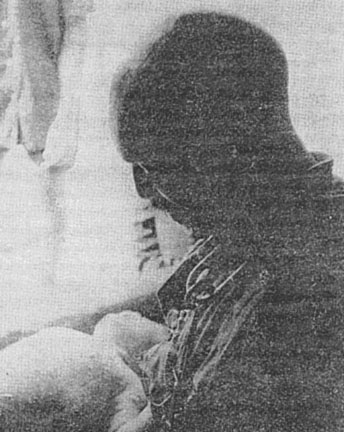 |
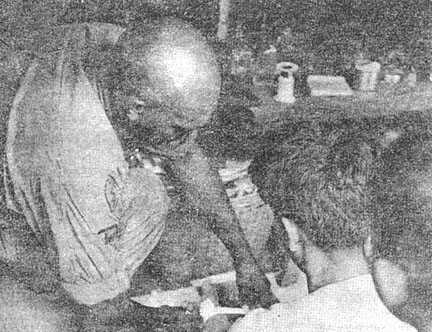 |
A villager has his cut foot treated. |
| After a day’s work in the hamlet, Coleman heads back to his unit. |
 |
Mail Call Is Well Attended
Viet Cong morale in Hau Nghia Province probably suffered a serious blow when
a 25th Inf Div Recon Platoon captured a Viet Cong mail clerk.
The unit, part of the 1st Bn, 27th Inf “Wolfhounds”, was patrolling an area
near the Oriental River northwest of Saigon during the 2d Bde’s Operation “Kolekole”.
“We had just crossed a canal,” said pointman Sgt Charles Williams of Walker,
W. Va., “When we spotted three armed VC walking down a trail about 150 meters
away. They didn’t see us.”
As the unit closed in on the enemy soldiers the VC glanced back and began
walking faster.
“They split up and started running,” said Williams, “so we divided the
platoon and started the chase. We hadn’t closed much when they disappeared into
hedgerows.”
Crashing through the thick growth, half the platoon overtook one VC who
stopped to chase his water buffalo into the bush.
“When we came through the hedge,” said SP4 Ricky Brown, a rifleman from
Gastonia, N.C. “I saw him beating two buffalo and hanging on for his life as
they half dragged him into the woods. When he let go I fired a few shots into
the air, but he kept running.”
Brown fired and wounded the man, who was given first aid and evacuated for
treatment and questioning.
Meanwhile, the remainder of the unit caught one VC attempting to escape from
a house he had hidden in. The man was loaded heavily with letters and
documents.
“Our Vietnamese interpreter talked to him,” said Brown, “and he admitted to
being a Viet Cong messenger and mail clerk.
The VC mailman was flown to the 25th Div base camp for further questioning.
Certainly Not Lady Luck
An ambush patrol from the 3d Sqd, 4th Cav, had a brush with a lady with an
itchy trigger finger and a bad aim.
The patrol consisting of 25th Div cavalrymen and popular forces infantrymen
were set up just outside the hamlet of An Duc in Tay Ninh Province.
Near midnight, two figures were seen approaching the patrol. One of the
figures was male and all patrol members agreed later that the second was a
long-haired female and rather pretty.
One soldier added that her looks did not match her disposition because she
opened fire. The patrol returned the fire and later checked the area, finding a
U.S. M-2 carbine.
Her aim was bad - there were no friendly casualties.
Army-AF Account For 15 VC
DAU TIENG - An alert Army air observer, an efficient Air Force forward air
controller, and the pinpoint bombing of two flights of jet bombers accounted for
15 Viet Cong killed approximately 48 kms northwest of Dau Tieng.
Flying his regular aerial reconnaissance mission over the northern section of
War Zone C, 1LT Ralph F. Campbell, an aerial observer from the 3d Bde, 25th Inf
Div, spotted three armed Viet Cong walking along a trail.
“As I watched, the three Charlies turned into seven, as four more moved onto
the trail.” said Campbell. “They were out of artillery range so I called Air
Force control at Dau Tieng and they sent one of their planes up to meet us.”
While the Air Force forward air controller headed for the area, Campbell and
his pilot, 1LT Leroy A. Burkemper of the 21st Aerial Reconnaissance Co scanned
the trail and six more Viet Cong appeared.
“All the VC went into an isolated clump of trees along the trail.” continued
the sharp-eyed officer. “They were strung out down the trail for about 2000
meters and as each one reached the trees, they would cut off the trail. It
seemed as if they were going to have a meeting or eat lunch.”
When CPT Richard Butka, a forward air controller for the 19th Tactical Air
Support Squadron, arrived over the area, the 13 Viet Cong were all grouped in
the small stand of trees. Flying up from the south, Butka spotted two more
late-comers walking up the trail which pushed the total to fifteen.
While Campbell kept an eye on the unsuspecting enemy, Butka coordinated with
the flight of three F-100 fighter bombers which were orbiting high above the
target laden with bombs.
Suddenly, the Viet Cong decided to start moving down the trail again. To
keep them out of the nearby jungle, LT Burkemper banked his O-1E Birddog down
toward the enemy who scampered back into the trees. The Army plane then
continued on, allowing the wary Viet Cong to think that they had not been
spotted.
Right behind the small brown Birddog, however, came the gray Air Force O-1
which sent a marking rocket into the trees. Before the white smoke of the
rocket had drifted in the wind, a 500 pound bomb from a streaking F-100 was on
target.
“They didn’t have a chance to go anywhere” said Butka. “The first bomb was
right in there and the rest leveled the entire area.”
In addition to the fifteen Viet Cong killed, a large store of supplies hidden
in the trees was destroyed.
Page 4-5 TROPIC LIGHTNING NEWS October 30, 1967
Chinook Resupply For Barking Sands
Photos By
SP4 Bill Wermine
The 1st Bde’s Operation “Barking Sands” leveling the trackless Ho Bo
Woods, must be supplied entirely by air – making it one of the largest efforts
of its kind ever attempted by 25th Div elements.
Daily, giant CH-47 “Chinooks” lift off the Viking Resupply pad with an
average load of about 2 ½ tons. In nine to 10 hours in the air, they make
thirty to forty sorties to brigade headquarters at Trung Lap and the battalion’s
forward base camp.
Among the most needed items of resupply are POL for the mechanized 4th Bn,
23rd Inf and the Rome Plows of the 27th Land Clearing Co; and ammunition for the
supporting mortar and artillery.
The frequently moving units cannot establish supply dumps, making resupply a
daily necessity. As a result, the number of Chinook loads required each day is
about twenty-times what it would be if roads were available.
It’s not all fuel and ammo though. The Chinooks and UH-1D “Hueys” too – from
the 25th and 269th Aviation Battalions, also carry sandbags, barbed wire, mail,
ice and a steady parade of troops. In addition, there is at least one hot meal
and two cans of liquid refreshment per man flown out to the field each day.
| SUPPLIES COME IN ALL SIZES, SHAPES AND FORMS | 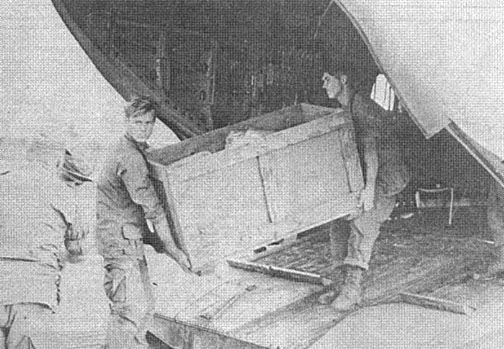 |
 |
SMOKE DIRECTS SUPPLY SHIP IN TO CAMP
|
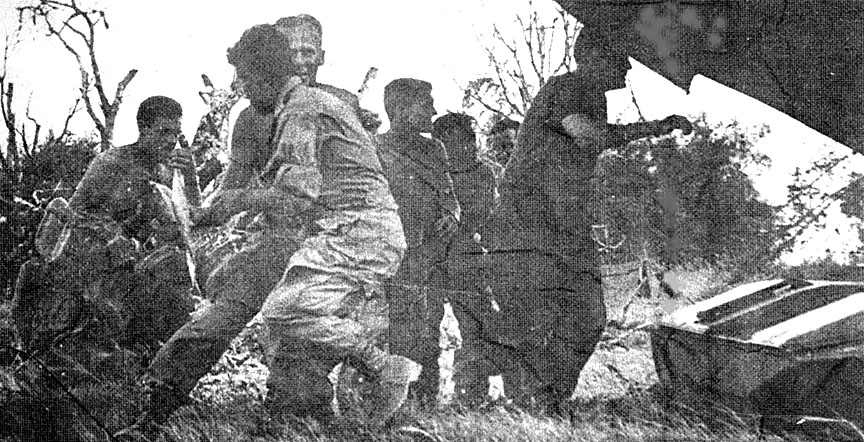 |
|
TO GET THE SHIP OFF THE GROUND FAST, SPEED IN UNLOADING IS ESSENTIAL |
| 1LT DALE KREUTTER OF COLUMBUS, GA., SHOWS THE PAIN OF STATIC ELECTRICITY DURING HOOKUP |
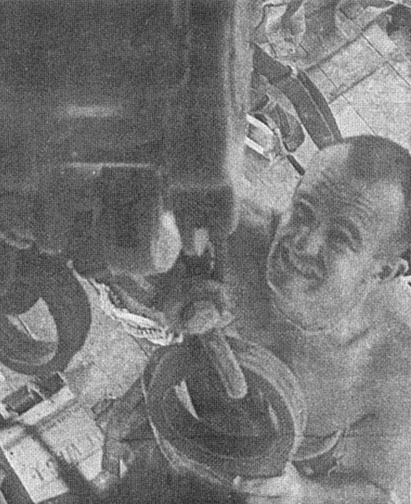 |
 |
AT TOUCHDOWN A SOLDIER STARTS TO UNLOAD |
| TO THE LEFT AND SET ‘ER DOWN |  |
Page 6 TROPIC LIGHTNING NEWS October 30, 1967
Boys Quicker
Tri-language Speech Class
DAU TIENG - SP5 Marcel L. Descheneaux, Manchester, NH, has a unique job in
the 3d Bde, 25th inf .Div. He’s the only American teaching English in the Dau
Tieng High School. Descheneaux has been teaching English, with the assistance
of an ARVN interpreter, to 160 students, ages 6 to 61, for the past two months.
When asked how his students were doing, Descheneaux said that they were quick
to learn the language. He said the boys were a little quicker at learning
English than the girls, perhaps because more is expected of the boys. He also
stated that he had no real difficulty getting the lessons across. The lesson is
first given in English, then the interpreter gives it in Vietnamese. If some point is misunderstood,
Descheneaux’s command of French helps straighten it out since most of the
students have already had three years of French.
Specialist Descheneaux is with the 2d Civil Affairs Co. under the command of
2Lt. Charles Wray of San Bernardino, Calif. According to Lieutenant Wray,
Descheneaux has been teaching eight to ten hours a day at the high school.
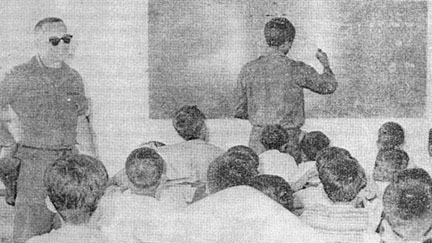 |
Descheneaux pauses in his lesson while an ARVN interpreter gives the same English lesson in Vietnamese. (Photo By SP4 Vince Housden) |
Dogfaces Now Attending Church Often
Has the chaplain gone to the dogs or have the dogs gone to the chaplain?
That’s the question plaguing men of the 1st Bn (Mech), 5th Inf.
“It began a long time ago,” said the battalion chaplain, MAJ Thomas J. Downs
of Chicago.
“I hold many of my Sunday services in the field, since the “Mech” is very
seldom in base camp.”
“The mascot of the medical platoon, a dog named Lady, attended my service one
Sunday and must have enjoyed it,” he said, “because she has continued to be one
of my regulars.”
After a few Sunday services, Lady began bringing a few of her friends, four
more mascots from other units in the battalion.
The dogs show up every week and sit silently throughout the services. After
church, it’s back to play.
“I’ve been accused of counting the dogs in the attendance report that I turn
in,” said the 25th Div chaplain with a smile, “but after all, they’ve proved
themselves good churchgoers. It’s a secret I’ll never tell.”
| Men of the 1st Bn (Mech), 5th lnf, keep home in mind with this rice paddy street
sign outside their Operation “Kolekole” camp. (Photo By SGT Roger Smith)
|
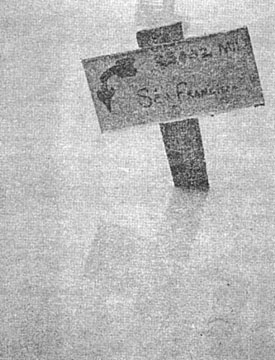 |
Dodge City Of The Far East
Thai My has the look of a peaceful Vietnamese agricultural hamlet but men of
the 1st Bn, 27th Inf “Wolfhounds” refer to it as the Dodge City of Hau Nghia
Province.
The town was famous for gunfights as Vietnamese Popular Forces and local Viet
Cong moved in and out of the hamlet freely, both claiming it as their own.
The stalemate was smashed recently when the 1st Bn (Mech), 5th Inf moved
toward the village with a column of armored personnel carriers with the hope of
holding a MEDCAP for the townspeople.
As they approached, the west side of town erupted with small arms and
automatic weapons fire. The column was pinned down for six hours before it
could move.
The following day the “Wolfhound” battalion was ordered into the hamlet by
the 25th Inf Div’s 2d Bde.
When they arrived, the same greeting met them. But in this shootout, the VC
lost, and the battalion, working with Vietnamese forces pushed into the village.
Extensive combat sweeps and MEDCAPS took place. More than two hundred
townspeople were treated in the first day alone.
After continuing civil affairs and psychological operations, the people began
volunteering information on VC gunslingers who used to travel freely in the
town.
By the time the “Wolfhounds” left their Dodge City, the village chief had
collected the name and pictures of more than 100 VC suspects and peacekeeping
operations were well undo way.
No Visitors Tonight
The hours pass slowly in a bunker at night but at least one 2d Bn, 14th Inf
soldier would prefer boredom to the kind of excitement that occurred recently.
SP4 Robert E. Ross of Eugene, Ore., heard a rustling sound in the bunker. He
and two other men switched on his flashlight to investigate.
“The first thing the light picked up was two beady eyes,” Ross recalled,
“then we made out a hood behind the eyes and the damn thing began to hiss.”
The men stood frozen until Ross picked up an ammo can and threw it at the
weaving form. Springing forward he killed the intruder with a stick.
On examination, the midnight visitor turned out to be a six-foot king cobra.
Bare Paddy Trail
A wily Viet Cong thought he could evade searching troopers from Co B, 4th
Bn, 9th Inf by hiding in a rice paddy while the Manchumen were operating north
of Trung Lap in Hau Nghia Province.
The 25th Inf Div unit was airlifted into the area where intelligence sources
said was a VC medical resupply area. After meeting and returning moderate small
arms fire at the landing zone, the infantrymen swept northeast, discovering and
destroying numerous freshly-built bunkers.
Two armed VC ran out of a bunker as Co C’s 3d Plt systematically searched
closer and closer to their location and were killed as they darted from the
woodline.
Meanwhile, Co B’s 1st Plt had flushed another VC, but he was quicker and
escaped through a hedgerow. “We went over to check out where he had
disappeared,” said PSG Newman Brumlow of Erwin, N.C., “and what do you think we
saw? A trail leading us right to him. He was submerged in the next rice paddy,
breathing through a hollow piece of bamboo. He was well hidden but he had left
his clothes scattered from the woods right down to the water.”
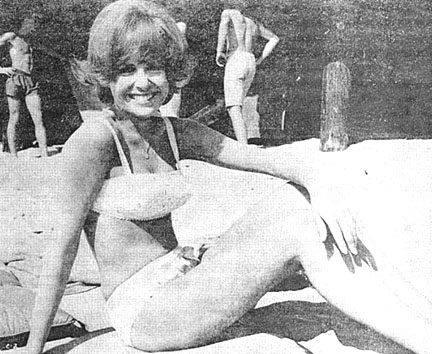 |
YES SIR - Deborah Walley is an actress and Deborah Walley is Niiiiice. Yes
Sir! (Photo Courtesy Trans American Film)
|
Page 7 TROPIC LIGHTNING NEWS October 30, 1967
| The seriously ill Vietnamese woman is carried by MEDCAP officials from the 3d
Sqdn, 4th Cav to the waiting dustoff helicopter. (Photo by SP4 David Cushman)
|
 |
Cav ‘Dustoff’ Saves VN Woman
The 3d Sqdn, 4th Cav was conducting its usual MEDCAP in An Duc.
Teeth were pulled, infections were washed and dressed, the Bac Si (doctor)
performed his usual “miracles.”
At 11 a.m. two Armored Personnel Carriers (APC’s) from Alpha Troop rushed
into town escorting a three-wheeled Lambretta carrying a seriously ill
Vietnamese woman.
The two APCs had been set up to provide road security further north on the
road. The crews had been alerted to the woman’s condition by civilians. They
called squadron headquarters, receiving instructions to transport the ill woman
to the MEDCAP in An Duc.
CPT Robert Pruner, squadron surgeon from Lebanon, Va., diagnosed her
condition - an overdose of an unknown drug.
Her pulse and breathing were barely noticeable. CPT Robert Kesler, squadron
civil affairs officer from Minneapolis, called for a Medavac helicopter from the
25th Div’s 12th Evac Hospital.
Minutes later the chopper landed on the main street of An Duc. The woman,
her husband and daughter were all taken to Cu Chi.
Hospital officials listed the woman’s condition as fair.
Manchu Civic Action Multiplying All Over
The 4th Bn, 9th Inf (Manchu), commanded by Stanley P. Converse of Falls
Church, Va., is actively engaged in fighting on two fronts - the war to subdue
the Viet Cong and, at the other end of the scale, the war to gain the local
citizens’ confidence and goodwill.
Vietnamese-American goodwill and cooperation are at an all time high in Kheim
Hanh District, Tay Ninh Province. The winning combination of the Vietnamese
Revolutionary Development (RD) cadre and the S-5 (Civic Action) team of the
Manchu Battalion, headed by CPT Edwin W. Richardson of Perris, Calif., has
scored many successes.
During the elections, for example, 91 percent of the registered voters
visited the polls, an impressive show of confidence in the democratic philosophy
of the RD-Manchu program. In another facet of the program, the people of Cao
Phu hamlet now have their own local newspaper, The Tribune; articles are written
by local citizens and it is published monthly by the battalion.
Most recently, Converse presented rabbits to several Cau Phu citizens who
wished to start raising rabbits. They were purchased through the S-5 and were
raised and cared for by Headquarters Company’s Heavy Mortar Platoon.
“The people will not only have a new source of income,” explained Richardson,
“but also another dish to add to their diet.”
1LT Andonios Neroulias, the Mortar platoon leader from New York City,
commented, “When Richardson approached me with the proposition of having my
mortar platoon participate in some civic action programs, I was more than glad
to accept the challenge of being useful in other than destructive means.
“Most 25th Div soldiers understand that we cannot win this war merely through
our military might. To eliminate the threat of a Communist takeover we must win
the local people to our side. The best way to accomplish this is through the
pacification programs.”
The rabbit farm idea has caught on rapidly throughout the area as farmers in
Suoi Cau, Ben Bang and Long Cong have applied for breeding stock. Asked if his
section intended to supply more bunnies, Richardson replied, “We certainly do.
Helping people to help themselves is our job and we intend to continue doing it
through this program and others like it.”
Canteen Leak
Just Too Close
The enemy’s aim wasn’t quite good enough to hit SSG Jorge Quinones of Baymon,
P.R., a platoon sergeant in Co B, 2d Bn, 14th Inf, but his equipment is a mess.
While participating in a battalion-size search and destroy mission near the
Saigon River his platoon came under heavy sniper fire. “As we were maneuvering
through a sugarcane field,” he explained, “I heard bullets buzzing around me. One bit my M-16
and sent chips from the stock into my face.”
A few seconds later the three-time 25th Div Purple Heart winner was spun
around and thrown into the mud by a large caliber bullet. “I thought I was hit
for sure,” he continued, “but while I was on the ground I felt for blood but
couldn’t find any.” He got back on his feet and continued to lead his platoon.
When he reached the area where the company was going to bivouac for the
night, Quinones removed his web gear and to his surprise found it torn to
shreds. The bullet that had knocked him down had pierced both his canteens, his
pistol belt, ammunition pouches and had ripped through a tightly rolled poncho.
As he unrolled the shredded poncho he asked of a friend, “Do you think I can
turn this in for salvage?”
| SUNDAY DRIVE - When elements of the 4th Bn, 23d Inf, were sweeping through the Ho Bo Woods, they uncovered this Simca hidden in the heavy jungle. All the side windows were kicked in and the interior was in bad condition. (Photo By LT Peter Bushey) |  |
| The 208 page color and black and white yearbook is the story of the 25th
Infantry Division from October 1966 to October 1967. It follows the Tropic Lightning Division operations through the Boi Loi and Ho Bo Woods, the Michelin and Filhol Plantations and the many nameless but not forgotten swamps and rice paddies. Price per copy is $4.00. This includes prepaid delivery to each subscriber WITHIN the United States. Delivery will ONLY be made in the United States. Payment may be made by American cash, check or money order. Stamps, piasters, or MPC will not be accepted. All orders must be in no later than 1 December 1967. Send your order to Albert Love Enterprises, lne., P.0. Box 1000, Doraville, Georgia 30040 |
Page 8 TROPIC LIGHTNING NEWS October 30, 1967
Extended Laterals Save APC Drivers
Scrap metal and a couple of hours work have saved four lives in the 4th Bn
23d Inf - and promise to save others in the future.
The mechanized infantry battalion has been seeking ways to prevent casualties
when an armored personnel carrier hits a mine. The APCs no longer carry anyone
other than the driver in the lead track and explosives and demolition equipment
are carried in a separate trailer.
Track drivers were still vulnerable however, if the vehicle detonates a mine
on its left side it usually blows the bottom out of it, a detonation on the
right pushes the engine into the driver’s seat. In either case, the driver is a
casualty - most often killed.
Now a modification of the steering mechanism has lifted the driver out of
danger. Called “extended laterals”, the device consists of two long bars that
slip over the laterals - or steering apparatus - and a third bar that bolts on
the accelerator pedal.
The bars extend up out of the driver’s hatch and allow him to steer from the
top of the track. If the vehicle detonates a mine, the worst that can happen is
that he will be thrown to the ground. He may be injured by the fall but the
alternative is death, trapped inside the driver’s compartment.
The idea for the modification originated in a mess hall brainstorming
session among battalion officers and members of the reconnaissance platoon.
“There were a lot of ideas tossed around,” recalls recon PSG John F. Shiflet
of Sumter, S.C. “We decided to give a couple of them a shot and this was one of them.
“It takes about 30 minutes for a welder to put a set together,” he
explained. “The bars can be slipped on the steering laterals in about five
minutes. The accelerator bar takes a little longer because it has to be bolted
and bracketed.”
Each platoon’s lead track now is equipped with the extended laterals. After
a set broke recently when the track hit a mine, the Tomahawks began to install
the laterals in a second track so that a spare would be quickly available in
emergency. Two spare sets also are carried by each platoon.
The modification has already proved its worth. On the second day of its
trial week with the recon platoon, a modified track hit a mine. The driver was
thrown off, suffering only a cut over his eye.
The anti-tank-mine was made from a 155mm round and had knocked the engine out
of its compartment to a position resting on the driver’s seat. A fist-sized
piece of steel had been driven up through the seat.
“I’ll let you imagine what would have happened to that man had he been
inside,” Shiflet commented.
In the first week of the experiment, the extended laterals saved the lives of
three more drivers.
His new position atop the track leaves the driver exposed to small arms fire
- a threat that has not materialized so far - and that is the battalion
brainstormer’s next project. Under consideration is a variation of the tank
commander’s three-sided shield.
| TAKE IT EASY - A soldier from the 2nd Bn, 14th Inf, wounded during a mortar attack is helped to a dust off helicopter by two medics. (Photo by SP4 John Seymour) | 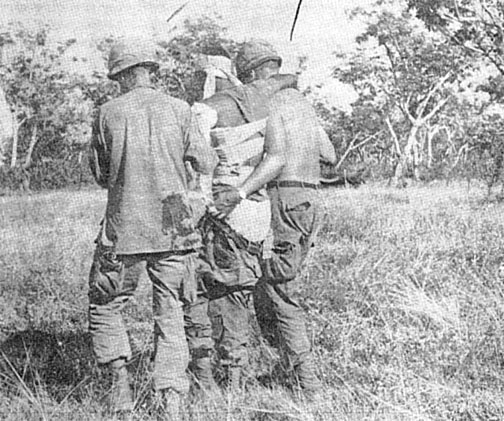 |
New Use For Mine Detectors,
Sure It Detects Fish!
Electronic mine detectors have proven effective to combat engineers operating
with the 25th Div, but one reported incident sounds a little fishy.
1LT Charles Fritts of Covington, Va., tells of how a mine detector crew from
Bravo Co of the 65th Combat Engr Bn, was clearing a section of road near Trung
Lap, 40 kms north of Saigon, when the instrument gave off a strong signal while
over a large puddle in the road.
“We probed through the water and found no evidence of metal,” relates Fritts,
“but we did find a nine-inch fish.”
The fish was caught and a second reading was taken to verify the accuracy of
the detector, because according to Fritts, the men were planning to market the
instrument for sale to fishermen.
Stay Low,
Strike Fast
Result - 3 VC
A picture-perfect ambush by mechanized troopers of the 25th Inf Div’s 2d Bde
recently accounted for three enemy killed.
Soon after sundown, the patrol moved out through the 1st Bn (Mech), 5th Inf
protective wire into the tangled darkness.
A silent, 900 meter march brought them to the selected site where they formed
an L-shaped ambush across a suspected Viet Cong supply trail.
“We were in position about an hour when I heard voices coming down the trail
toward me,” said SP4 Gary Bradac, a team leader from Corunna, Mich.
Every man crouched lower and raised his weapon to firing position as three
armed Viet Cong soldiers walked directly onto the ambush site.
“It was just like they taught us,” said Bradac, “I let them get almost on top
of two claymore mines and let them have it.”
The ripping blast killed two Viet Cong and wounded the third. As he
attempted to return tire, he too was killed, by small arms fire.
Weapons Shop
2/27 Hit Cache, Repair Area
A point man’s sharp eyes recently resulted in destruction of a large Viet
Cong weapons cache and repair site on the edge of the Boi Loi Woods, 45 kms
northwest of Saigon.
SGT Harold D. Sumrall of Palestine, Tex., found the first part of the cache
during a halt in a 25th Inf Div combat sweep.
“At first I thought it was a punji pit,” he said, “but there was a rifle
barrel sticking up through a black poncho cover.”
Inside, men of Delta Co, 2d Bn, 27th Inf “Wolfhounds” found one shotgun and
27 rifles.
For the next two hours, the infantrymen scoured the tangled jungle site and
found one large command bunker, a weapons repair area and five more shotguns.
The repair area was complete with workbenches, vises, metal working tools, a
cartridge loader and bullet mold.
A pile of small arms ammunition, explosives and artillery rounds were
destroyed by engineer demolition men.
Earlier, the battalion’s Charlie Co tore into a large storage cache to the
south,, and destroyed 100 rounds of .50 caliber ammunition, 5 grenade launcher
rounds, a claymore mine and detonating device, an oxcart axle, six flare
casings, 100 sandbags, clothing and tools.
The “Wolfhound” unit is taking part in the 2d Bde’s Operation “Kolekole”.
The combat operation has accounted for 580 Viet Cong dead since 13 May.
| PART OF CACHE - Soldiers of the 2d B, 27th lnf “Wolfhounds” carry some of the Viet Cong weapons they uncovered in the Boil Loi Woods. (Photo by 1LT Al Karel) |
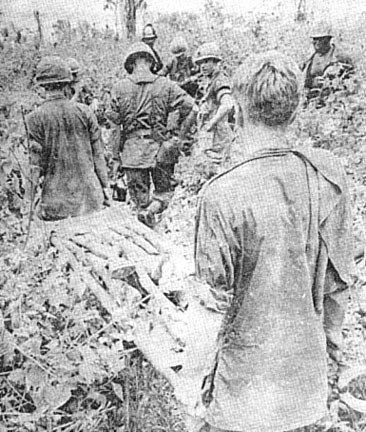 |
Thanks to:
Robert Doty, 2nd Bn, 14th Inf.,
for sharing this issue,
Kirk Ramsey, 2nd Bn., 14th Inf. for creating this page.
This page last modified 04-30-2009
©2009 25th Infantry Division Association. All rights reserved.